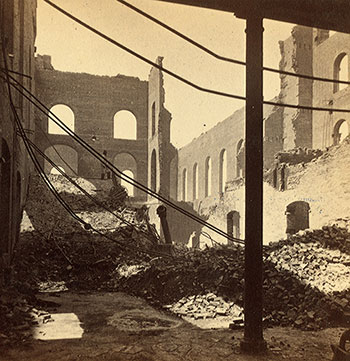From the Rubble of City Hall's Jail, a Faint Cry
The day after the fire, Marshall Sterling, a retired police deputy, was surveying the damage at City Hall, which was gutted by the Great Fire of 1866, with only some exterior walls remaining. The building housed the county jail in the basement.

Portland’s new City Hall was gutted by the fire that ripped through a third of the metropolitan area in the summer of 1866. To his astonishment, retired police deputy Marshall Sterling the next day discovered an inmate in City Hall’s jail who had survived the conflagration, a man who “was not even scorched.” Photo by John P. Soule
At around 10 a.m., Sterling was shocked to hear a faint cry from beneath the rubble, as he thought all of the prisoners had been freed before the fire reached City Hall.
He would describe his discovery 30 years later:
“I crawled over the piles of brick into the cell room and found a man in cell 15. He had been forgotten when the cells were unlocked and had stayed where he was while the building burned over and around him. The cell was on the west side of the room and he got air, the high wind blowing into the room through an open window. The cell room, then, as now, was partly finished in wood laid on brick and iron. The door to the patrolmen’s room and that to the yard had been burned out, and the woodwork in the east corridor of the cell room had been burned, but the man was not even scorched, thanks to that open window, the high wind, and the fact that he was on the west side instead of the east.”
Witnesses and Survivors of the Great Conflagration
The Man Who Shouted "Fire!"
William Wilberforce Ruby is remembered for his animated role in calling attention to the Great Fire, but he also went on to serve and lead the city.
MoreA Businessman as Resilient as the City
John Bundy Brown was the state’s wealthiest resident and Portland’s largest landowner, and he would not let the fire defeat him.
MoreFamous Portlanders Touched by Fire
Poet Henry Wadsworth Longfellow and architect John Calvin Stevens are affected by the disaster in different ways.
MoreThe Forgotten Prisoner
From beneath the rubble of City Hall’s evacuated jail, a faint cry is heard.
More
Tell your friends